Squirrels are some of the most adorable critters that will ever grace your yard. They’re fun to watch, fun to feed, and make great pets. Unfortunately, they can also be a nuisance when the weather gets cold or you’re trying to attract birds using feeders.
Another potential problem is that these intelligent critters can cause damage to your home and garden. Much of this is unintentional, although damage to wood and plants could be the result of foraging. There are also rumors of squirrels who cause accidents for unwary drivers in exchange for an insurance kickback, but these rumors are unconfirmed.
Keep reading to learn the professional secrets for getting rid of squirrels and keep them from coming back.
Getting Rid of Squirrels
Squirrels and other wild rodents can be difficult to get rid of. Not only will they figure out how to bypass barriers given time, they can also catch on to deterrents and learn to ignore them. Thus, you need to follow up any attempt to get rid of these critters with exclusionary techniques so they don’t have a chance to come back.
How to Get Rid of Squirrels in the Attic
Cold weather can lead to all sorts of home invaders, especially in areas where trees are sparse. Squirrels are no exception to this, and the little guys can do a lot of damage to the wood in roof, wall, and floor structures.
There are three basic ways to get squirrels out of your attic, two temporary and one more permanent. We do not support the use of poison, and it might actually be illegal in your area to kill squirrels, although chipmunks may be different.
Note: Your need to seal all potential access points to prevent squirrels (or other critters) from returning once you’ve used these methods.
Related: Common Pests in the Attic
Use a Squirrel Repellent
Using repellents can temporarily get rid of a squirrel infestation, but may not be a good long-term solution. Sonic repellents are a mixed bag, as squirrels can quickly adapt to ultrasonic noise or the sound of people. Ultrasonic devices can also affect your pets, so it might be best to avoid using them in the house.
Chemical repellents are more successful, although not perfect. You can find plenty of repellent sprays that are formulated to smell like predator urine on the market. These will often (but not always) be enough to make a squirrel evacuate the attic.
You can also make your own homemade repellent sprays. Try using things with a strong smell, such as white or apple cider vinegar, peppermint essential oil, or garlic.
Mix them with water in a spray bottle (you may need to add a tiny bit of Dawn dish soap so any oils will blend) and spray where you think squirrels are frequenting. These sprays will need to be reapplied every few days to remain effective.
Finally, consider sprinkling some food-grade diatomaceous earth or cayenne pepper where you know the squirrels run around. Both are very uncomfortable for the squirrels to walk on and they’ll usually begin avoiding that area after a few encounters.
Squirrel Traps
One of the best ways to remove squirrels from your attic (or anywhere else, for that matter) is to use a squirrel trap. You’ll want to use a smaller trap (17x7x7 or 18x6x6 inches are commonly recommended sizes) so these adorable critters won’t hurt themselves if they panic.
You can easily purchase a trap online (such as this Havahart squirrel trap) or from your local hardware store. It may even be possible to rent one from a local animal control agency.
Stick the trap in a corner or somewhere else less obtrusive and add some bait far enough back to prevent a grab’n’go. Apple slices, saltines, peanuts, and peanut butter are all excellent types of squirrel bait. Once captured, be sure to check for any baby squirrels.
You’ll also need to check local regulations when deciding how to trap a squirrel (by yourself or through a professional), as some areas won’t allow the transport of wild animals. For those that do, you’ll need to take a squirrel ten miles away (twice as far as most other rodent species).
Put on some heavy gloves before opening the trap, and use a rope to open it from a distance if the squirrel is acting aggressive.
See Also: Best Squirrel Traps and Repellents
Exclusion
The best way to deal with squirrels (or other critters, for that matter) is to install exclusion devices. These one-way portals allow a squirrel to leave but not return. Once all pests are gone, it’s always recommended that you remove the device and seal the entrance point completely.
DIYers might want to try building their own version which works well enough on squirrels but not other critters (such as bats). This device is simply a metal funnel made of fine mesh or sheet metal. The funnel should be a foot long and 12 to 15 inches wide at the top end. The small end should be as wide as the opening the squirrels are using.
Place the funnel against the outer wall with the small opening pointing away. Squirrels can get out, but will have a difficult time making it back in.
When You Need a Professional
Sometimes you just can’t get rid of the squirrels on your own. The professional squirrel removal cost varies from place to place, and the number of squirrels or amount of damage can play a huge role in the final fees.
According to Costhelper, the price of removal may cost anywhere from $300 to $1,500. Inspection fees can range from free to $300.
How to Keep Squirrels Out of the Garden
One of the biggest frustrations caused by squirrels is in the garden. These critters love young shoots and fresh produce. Keeping them out isn’t always easy, but it can be done with a little planning.
Barriers
One of the easiest ways to protect your garden space from squirrels and other pests is to add a barrier. Placing mulch around seedlings will make squirrels less likely to dig them out. Row covers or a combination of chicken wire walls and bird netting roof will keep your plants safe so long as nobody teaches squirrels how to use wire cutters.
See Also: How to Fill in Chipmunk Holes
Deterrents
One of the best ways to keep squirrels out is to give them a reason to stay away. Having pets that enjoy a romp with these critters can make them think twice about paying your yard a visit.
Meanwhile, natural extracts, such as capsaicin, peppermint, and vinegar all make your plants unpalatable to hungry squirrels and have the added bonus of also deterring other pests. You can also attract natural predators, such as hawks or owls, to your yard if you aren’t also trying to attract songbirds.
Misdirection
Keep your bird feeders away from the garden and be sure to clean up any spills. Instead, offer similar goodies in spots that are as far from the garden as possible. The squirrels will focus on your free treats and be less interested in helping themselves to an early harvest.
How to Keep Squirrels Away from Bird Feeders
Squirrels are natural acrobats. Their toes can grip onto surfaces and their tails give great counterbalance, allowing them to climb vertical surfaces and even hang briefly to reach a hanging object. For this reason, it can be very difficult to keep them away from your bird feeders.
There are a couple good techniques to help deter a hungry squirrel from that delicious seed or suet, however. You might be surprised how cheap and effective some of these tricks are.
Hook and Pole Tricks
Squirrels can climb very thin surfaces, so simply putting your feeder on a pile or shepherd’s hook isn’t always sufficient. Don’t waste your money on expensive products, just squirt a little WD-40 on the pole or rub a small amount of Vick’s.
Not only will this keep squirrels from climbing, but it will also deter ants and other pests that might be eyeing the feeder.
Sharing Means Caring
One of the best ways to keep a squirrel from your feeder is to address the reason they’re going there in the first place. Creating a ground-based feeding area for the squirrels located at the opposite end of the yard will be enough to keep most of these adorable critters happy.
Squirrel Baffles
Squirrel baffles are a fairly cheap way to discourage squirrels from joining the bird buffet. These plastic domes fit under the feeder (and sometimes over). Underneath, it requires the squirrel to overcome a smooth arcing surface that’s curving down.
When above, the top of the dome makes it difficult for squirrels to get a good enough grip to keep from sliding off of the baffle. Note that baffles aren’t 100 percent effective and squirrels are known to puzzle them out, given enough time (as shown below).
Getting to Know Squirrels
Before you can hope to get rid of squirrels, you must first get to know the enemy. Just like mice, rats, prairie dogs, and other rodents, squirrels are unbelievably intelligent. Understanding their behavior will give you an edge on the battlefield.
Squirrels 101
There are somewhere between 200 and 250 species of squirrel in three major types: flying, ground, and tree. Each of these varieties can be a bane or boon to the average homeowner. Understanding the basic differences between each type of squirrel will help you plan prevention methods as well as conservation methods, if desired.
Flying Squirrel
Undoubtedly the most adorable of all squirrels, the 50 or so known species of flying squirrel don’t actually fly. Instead, they use a membrane, known as a patagium (which bats also have), to glide from one branch to another.
Being the smallest and most vulnerable squirrels, their gliding ability evolved to allow for the most efficient means of foraging.
As with most squirrels, flying squirrels are omnivores, although many species have a highly specialized diet. Their ability to catch lift and adjust direction while aloft allows these gliders to travel as far as 300 feet on a single leap.
Popular as pets, flying squirrels can easily become an attic nuisance due to their airborne method of travel.
Ground Squirrel
Of the 62 known species of ground squirrel, 38 live in North America. Their fur tends to be anywhere from grey to reddish-brown, usually including a camouflage pattern such as dappling or stripes and a lighter underbelly.
They have shorter tails than tree squirrels, as balance is less important. Most ground squirrels are omnivores, and those in colder climates will hibernate during the winter.
The red squirrel is perhaps the most famous species of ground squirrel. These little guys can be very territorial against similarly-sized threats (including small pets), and prefer having burrows at ground level. The European red squirrel is currently endangered, but the American variety is plentiful.
Tree Squirrel
The largest family of squirrels, there are 122 different species of tree squirrel in the world. They’re native to every continent except Australia and Antarctica. The North American gray squirrel is perhaps the best-known of all tree squirrel species.
Unfortunately, they are also responsible for the decline of the European red squirrel, whose habitats they have invaded.
Tree squirrels are highly intelligent and their curiosity provides plenty of entertainment. Unfortunately, their love of heights means they’re more likely to invade your attic or bird feeders.
Maintaining an ecological balance with tree squirrels is more difficult that with flying or ground squirrels, as humans continue to destroy their homes (and in response tree squirrels often damage human homes).
Squirrels and the Ecosystem
Squirrels are an important part of the ecosystem and can be of benefit to your yard if any potential problems have been addressed. There are three major ways in which having squirrels around can be useful:
- They help plant trees and flowers. Squirrels cache their seeds. While tree squirrels are best known for caching in tree hollows, ground squirrels bury seeds and nuts. Some of these they return to consume, but not all. The uneaten seeds sprout and grow, helping spread trees and flowers across your yard.
- They disperse beneficial fungi. Fungi is a vital decomposer that helps reduce compost and recycle dead plant matter such as tree stumps. Squirrels enjoy snacking on mushrooms and will poop out the spores, allowing mushrooms to grow where the airborne spores might not otherwise reach.
- They help with bug control. Do you have an insect problem? Being omnivores, squirrels like to snack on insects. You might not want them messing about in your garden, but they can still provide a valuable service against potential six-legged home invasions.
Squirrel-Based Problems
Unfortunately, squirrel activity can also lead to a lot of damage. For example, if they get into your home, they may chew up electrical wires or steal bits of insulation to make a squirrel nest. Gray squirrels are especially adept at getting into your home from the roof and wreaking havoc.
They’re known to tear up young plant beds to munch on tender young shoots. Later in the year, they’ll also snack on your vegetables and may damage flower beds while hunting bugs.
A hungry squirrel can also chase off songbirds so it can steal the bird seed. If you have an outdoor pet, this little rodent may go after any pet food left laying around.
Finally, you don’t need to use squirrel poisons to end up with a dead squirrel. Predators might kill one or their curiosity might lead them to eating something toxic. If you capture or kill a mother squirrel without checking the nest, her babies may end up dying. Either way, the corpse will create more than just a pungent smell, it can be a veritable disease factory and attract other pests.
Squirrels vs Chipmunks
While both squirrels and chipmunks are part of the rodent family called Sciuridae, squirrels in general are larger than chipmunks and have a longer, bushier tail. A common tree squirrel can be 12-20 inches in length while a common chipmunk only 6-12 inches (including tail).
Sharing Your Yard with Squirrels
There are times when you’ll want squirrels in the yard, either for watching or environmental reasons. Strategically place food and water sources in the yard, preferably in trees or on poles to prevent other rodents and ground-based pests from joining the feast. You can also put up a squirrel house to encourage them to move in.
Because of their love of mushrooms and insects, you may wish to encourage fungal growth in certain areas of the yard. By doing so, these critters will help you manage a compost heap by spreading fungal spores over the area.
You can also use clotheslines or other objects to create a squirrel playground near your favorite window and place treats in strategic points so you and your kids can watch their acrobatic antics.
Just be sure to protect any garden spaces and check for possible entry points to your home before drawing too much attention to the yard space. Remember, these critters can be beneficial and fun, but can also be problems to the unprepared.
- How to Get Rid of Hawks - March 8, 2024
- How to Get Rid of Pill Bugs (Rolly Pollies) - March 1, 2024
- How to Get Rid of Groundhogs (Woodchucks) - February 5, 2024

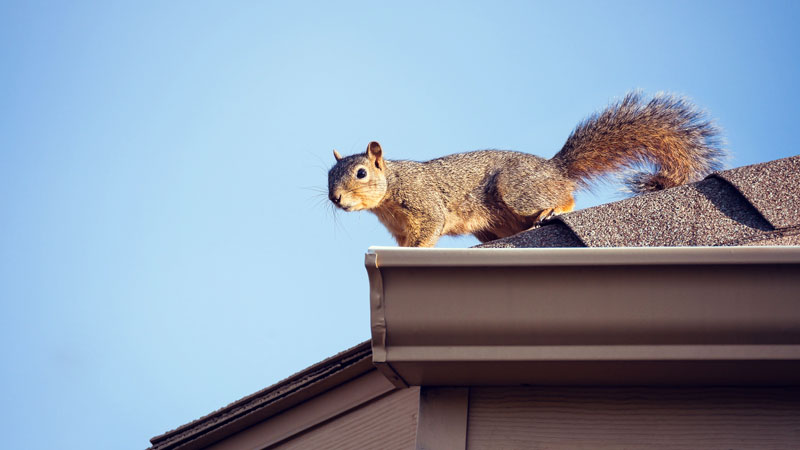

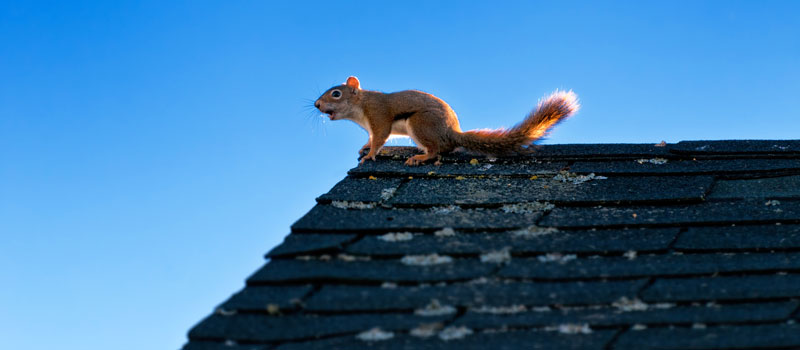
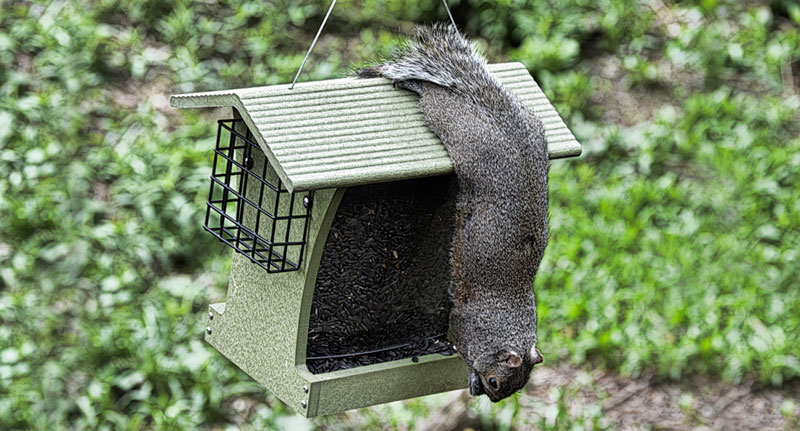
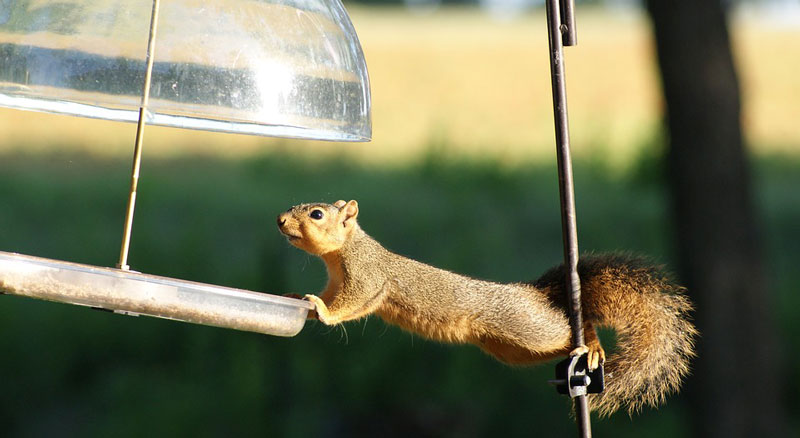
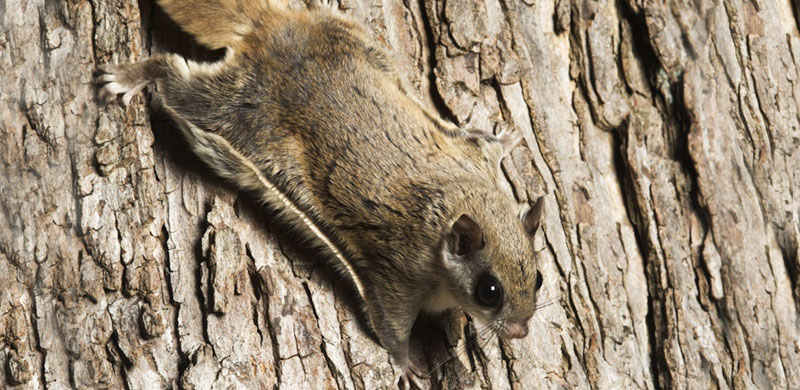
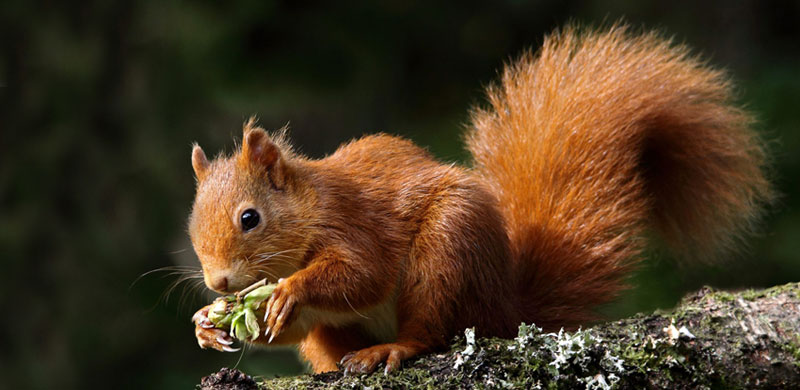
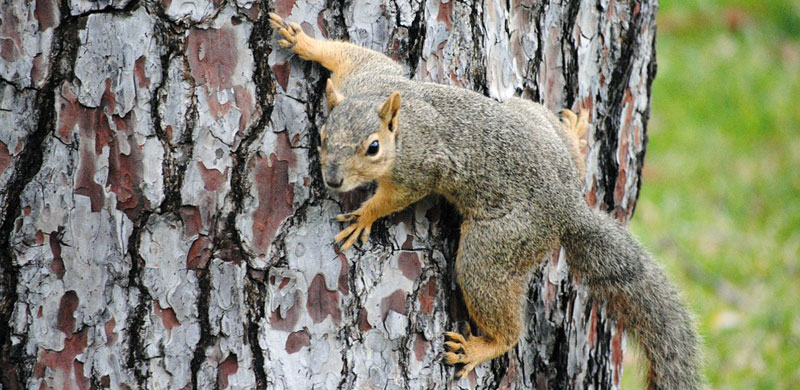
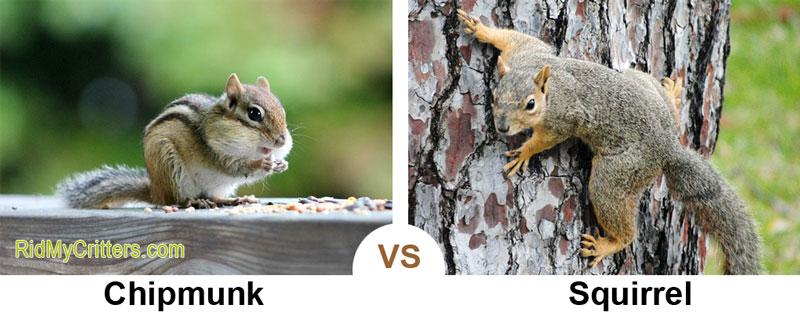
Is there anyway to keep them from eating your fruits on the tree?
Depends. If it is a medium-to-large single fruit tree that isn’t within jumping distance of other objects (house, tree, power line, etc.), you just need something to prevent them from climbing up the trunk. A metal (aluminum or tin) collar that’s about 2 feet tall can be attached to the trunk about 5-6 feet off the ground. Alternatively, a repellent such as Rodent Defense can be sprayed on or around the tree trunk (although you will need to reapply at regular intervals).
If the squirrel has access from your roof or nearby trees, there’s not much you can do other than hang some shiny objects (such as old CDs or strips of aluminum foil) in various parts of the tree in hopes of scaring them off.
Morgan: I have enjoyed reading your creature descriptions. You have an easy and sometimes humorous writing style. The differences between creatures like squirrels and chipmunks, or coyotes and dogs & wolves were especially informative for me. Thank you also for all the DIY and low cost suggestions. You seem to be a human who appreciates the earth’s natural environment. Thank you.
Thank you! 🙂
Years ago, we found that pest control sites were impersonal and often contained outdated or boring information. They almost always wanted you to hire a pro, and almost never considered the ecological importance of these critters. That’s a huge part of why RMC was created. Mother Nature has spent millions of years creating a balance that keeps the world healthy. Sometimes, that balance is disturbed (such as pest infestations, deforestations, etc.).
Understanding a critter and its role in nature is important to keeping the planet healthy, as well as why an infestation happened. True pest control is largely about restoring the natural balance so your home, garden, and nature are all happy and healthy. And, let’s face it, if we can put a smile on your face as well as help you learn to live with (or without, as the case may be) various critters, that’s just ice cream on the pie (we don’t do cake because the cake is a lie).